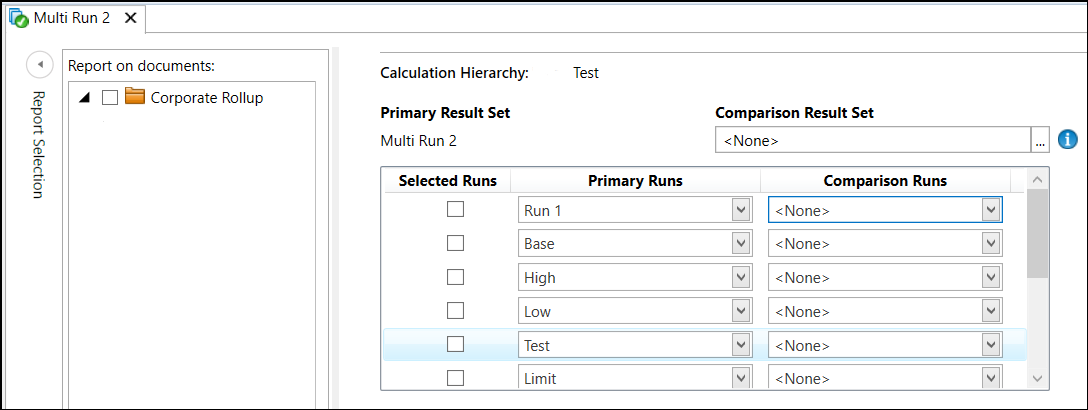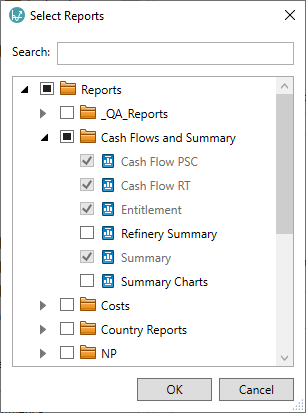Variance result set report
In Variance reporting you select two result sets, match up the corresponding runs from each result set, and then a 'delta' is calculated between the two result sets.
Subtractions are applied for the Numeric variables in the report template, while Text and Date variables take their values from the Primary result set run.
The output reports may use the same report templates as for Standard reporting but they will contain the delta data.
Configure Variance reporting
In the Result Sets explorer, double click a calculated run (that is, a run which has the icon
![]() )
to open it. This will be used as the selection for the Primary Result Set.
)
to open it. This will be used as the selection for the Primary Result Set.
Click the Variance button
 in the Report tab on the ribbon.
in the Report tab on the ribbon.

Select another result set to be the Comparison Result Set by clicking the ellipsis button ....
In the Runs box, use the checkboxes to check which runs will be included, and for each Primary Run selected, you need to select a Comparison Run from the other result set.
In the Calculation Hierarchy, select the folders and projects that you want to be included. You also need to use the Generate Reports For options in the Report Selection fields (see below) to specify how reports will be mapped to these folders and projects.
The hierarchy view will show (by highlighting in color) the differences between the two result sets, that is whether a folder/project is contained in only one of the two result sets, or in both.

The Calculation Hierarchy has a context menu (accessed using right-click) which allows you to Expand or Collapse the view of the contents of a folder, and to Select and Deselect the descendant projects and folders.
Set the Report Options and Additional Net Partners

Report Options Presets can be used to store settings and hence automatically fill-in this information (see Report Options presets).
Specify the settings for Options as shown in the table below.
| Setting | Description |
|---|---|
| Start Date | Specifies the start date for the result set report. |
| End Date |
Specifies the end date for the result set report. By default, this is set to its economic limit. However, you can change it to either a specific date, or a duration (fixed number of years). Note: The Start Date and End Date must be within the dates that were specified when the result set run was calculated. Values from outside of those dates cannot be returned. |
| Fiscal Year-End | For version 16.5 Update 7 and later: This setting can be used to set reporting to use fiscal years instead of calendar years; this specifies the end month of the fiscal year; in report outputs, year labels will have the form 'FY<YEAR>' to denote that fiscal years are being used. The default value is 'December', hence reports will use calendar years. |
| Currency & Discounting Preset | Specifies a Currency & Discounting Preset for the result set report; see Currency and Discounting presets. |
| Periodicity | Specifies the periodicity of displayed values: Annually, Semi-annually, Quarterly, Monthly, or Mixed. If Mixed is selected, additional fields for Mixed Periodicity Settings will appear; here you should specify the number of reporting years of each periodicity type (monthly, quarterly, and semi-annually; one or two of these can be set to zero), while any further years will revert to the annual basis. Note that if the report start date is set to mid-year then the initial partial year will be treated as the first year for the smallest-specified granularity. |
| Unit System | Specifies the measurement units, Imperial or Metric. |
| Unit Size | Specifies the unit size (Small, Medium or Large). |
| Real / Nominal |
Specifies whether or not to apply inflation to project values. The inflation date used will be the one that is specified in each project. For Version 16.5 Update 24 and later: Use the option From Template to apply the settings from the report template for individual linked variables, or use Real or Nominal to override the individual settings. |
| Default Partner | Allows you to specify the default values that will be displayed in the report. Gross will display 100%, while selecting a partner will display the corresponding share. |
Additional Net Partners

The partners that were made available for the result set run pre-calculation can be found in the drop-down menus (see Standard result set). The partners that you select here will have their corresponding share of any variables that have been linked to specific net partners displayed in the result set report (see Add a working interest share).
Select the report templates

In the Report Selection field, click Add. A Select Reports dialog will open.

Select the report(s) that you want to use. You can search for reports using the bar at the top of the dialog.
If no reports appear for selection, you will need to create a report template (see Create a report template).
Click OK to finish report selection and close the dialog.
Added reports will appear in the Report Selection field.
Set the checkboxes Generate Reports for: Folders and Generate Reports for: Projects to specify how reports will be mapped to folders and projects in the hierarchy.
Generate the result set report
When the setup is completed, click one of the Generate Report buttons to start the report generation.
See Result Set Reports.
